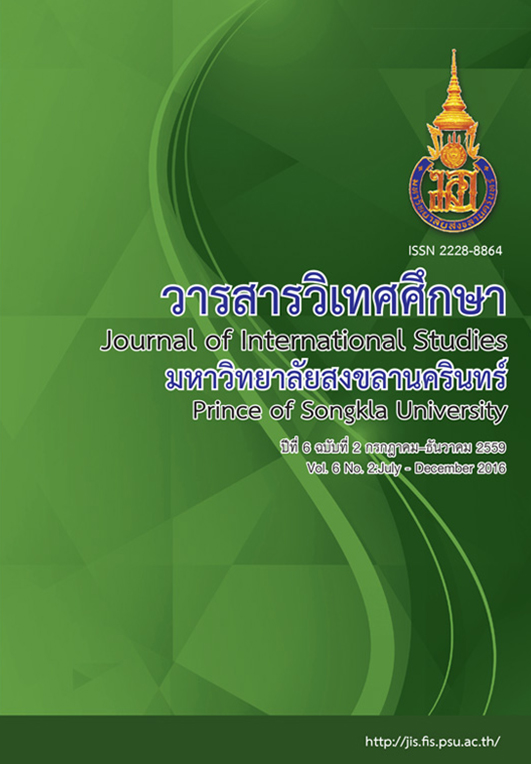ผลของการใช้รูปภาพที่มีคำบรรยายใต้ภาพและรูปภาพที่มีเฉพาะคำสำคัญใต้ภาพต่อความสามารถด้านการพูดภาษาอังกฤษของนักเรียนชั้นประถมศึกษาปีที่ 2
Main Article Content
บทคัดย่อ
วัตถุประสงค์ของงานวิจัยนี้คือเพื่อศึกษาผลของการใช้รูปภาพที่มีคำบรรยายใต้ภาพและรูปภาพที่มีเฉพาะคำสำคัญใต้ภาพต่อความสามารถด้านการพูดภาษาอังกฤษของนักเรียนชั้นประถมศึกษาปีที่ 2 และศึกษาปัจจัยเสริมและอุปสรรคของการใช้รูปภาพทั้งสองประเภทที่มีผลต่อความสามารถทางด้านการพูด กลุ่มตัวอย่างเป็นนักเรียนชั้นประถมศึกษาปีที่ 2 ของโรงเรียนประถมศึกษาของรัฐแห่งหนึ่งในจังหวัดสงขลา ภาคใต้ของประเทศไทย จำนวน 49 คน (หญิง 25 คน และชาย 24 คน) ซึ่งได้มาจากการเลือกแบบเจาะจง และสุ่มให้กลุ่มหนึ่งเรียนภาษาอังกฤษโดยใช้รูปภาพที่มีคำบรรยายใต้ภาพและอีกกลุ่มหนึ่งเรียนภาษาอังกฤษโดยใช้รูปภาพที่มีเฉพาะคำสำคัญใต้ภาพ ข้อมูลได้จากผลการทดสอบก่อน-หลังเรียน ความคงทน และผลการสัมภาษณ์กึ่งโครงสร้าง ใช้เกณฑ์การประเมินความสามารถทางการพูดของ CEFR ผลการวิจัยพบว่า กลุ่มที่เรียนภาษาอังกฤษโดยใช้รูปภาพที่มีคำบรรยายใต้ภาพมีการพัฒนาทางด้านการพูดเพิ่มขึ้นอย่างมีนัยสำคัญ จากระดับอ่อนเป็นระดับปานกลาง (Z= -2.236, p <.05) โดยเฉพาะในด้านคำศัพท์และด้านความถูกต้องในการใช้ภาษา ในขณะที่กลุ่มทดลองอีกกลุ่มหนึ่งมีความสามารถทางด้านการพูดเพิ่มขึ้นจากระดับอ่อนเป็นระดับปานกลางและระดับเก่งโดยมีทักษะด้านการมีปฏิสัมพันธ์ ด้านความคล่องแคล่วในการใช้ภาษา และด้านคำศัพท์เพิ่มขึ้นสูงอย่างมีนัยสำคัญทางสถิติที่ระดับ 0.01 (Z = -3.145, p <.01) ในการทำวิจัยครั้งต่อไปผู้วิจัยควรเพิ่มจำนวนผู้เรียนในกลุ่มทดลองให้มากขึ้น และเพิ่มกลุ่มควบคุม หรือเปรียบเทียบผลของการใช้สื่อที่ให้ข้อมูลภาพ คำศัพท์ และเสียงกับสื่อที่ให้เฉพาะข้อมูลภาพและเสียงต่อความสามารถทางด้านการพูดของผู้เรียนวัยเยาว์
Article Details
ข้อความและความคิดเห็นที่แสดงในบทความ เป็นแนวคิดของผู้เขียน มิใช่ความรับผิดชอบของกองบรรณาธิการ และคณะผู้จัดทำแต่อย่างใด
บทความ ข้อมูล เนื้อหา รูปภาพ ฯลฯ ที่ได้รับการตีพิมพ์ในวารสารวิเทศศึกษา ถือเป็นลิขสิทธิ์ของวารสารวิเทศศึกษา หากบุคคลหรือหน่วยงานใดต้องการนำทั้งหมดหรือส่วนหนึ่งส่วนใดไปเผยแพร่ต่อหรือเพื่อกระทำการใด ๆ จะต้องได้รับอนุญาตเป็นลายลักษณ์อักษรจากวารสารวิเทศศึกษา ก่อนเท่านั้น
เอกสารอ้างอิง
Al-Ja Afari, I. S. (2013). Using pictures in vocabulary in Grades 5 and 6 classrooms, Sharqiya South Region.
Bowen, B. (1982). LOOK Here! Visual aids in language teaching. Macmillan Publishers Ltd. London.
Brown, H. D, (2001). Teaching by principals. Pearson Education, New York.
Chang, C. S. & Read, J. (2007). Support for foreign language listeners: Its effectiveness and limitations. RELC. 38(3), 375 - 395.
Clark, J. M. & Paivio, A. (1991). Dual coding theory and education. Educational Psychology Review, 3(3), 149 -170.
Cook, G. (2000). Language play, language learning. Oxford: Oxford University Press.
Colon-Vila, L. (1997). Storytelling in an ESL classroom. Teaching Pre K-8, 27(5), 58 - 59.
Danan, M. (2004). Captioning and subtitling: Undervalued language learning strategies. Meta: Translators' Journal, 49, 67 - 77.
Dobson, M. J. (1992). Effective techniques for English conversation group. Washington: United States Information Agency.
Goh, C. (1999). How much do learners know about the factors that influence their listening comprehension ?, Hong Kong. Journal of Applied Linguistics, 4(1), 17 - 42.
Hayati, A., & Mohmedi, F. (2011). The effect of films with and without subtitles on listening comprehension of EFL learners. British. Journal of Educational Technology, 42(1), 181-192.
Kalyuga, S., Chandler, P., & Sweller, J. (1999). Managing split attention and redundancy in multimedia instruction. Applied Cognitive Psychology, 13, 351 - 371.
Lever, R., & Sénéchal, M. (2011). Discussing stories: On how a dialogic reading intervention improves kindergartners’ oral narrative construction. Journal of Experimental Child Psychology, 108(1), 1 - 24.
Linse, Caroline. T. (2005). Practical English language teaching: Young Learners. McGraw Hill, New York.
Lutz, S., & Huitt, W. (2003). Information processing and memory: Theory and applications. Educational Psychology Interactive. Valdosta, GA: Valdosta State University.
Mackay, P. (2006). Assessing young language learners. Cambridge: Cambridge University Press.
Madsen, H. J., Donald, B., & Ann, H. (1985). TESOL techniques and procedures. Cambridge, MA: Newbury House Publishers.
Mansourzadeh, N. (2014). A comparative study of teaching vocabulary through pictures and audio-visual aids to young Iranian EFL learners. Journal of Elementary Education, 24 (1), 47- 59.
Mayer, R. E. (2005). Cognitive theory of multimedia learning. In R.E. Mayer (Ed.), The Cambridge handbook of multimedia learning. New York: Cambridge University Press.
Mayer, R. E. (2009). Multimedia learning. New York: Cambridge University Press.
Paivio, A. (1971). Imagery and verbal processes. New York: Holt, Rinehart, and Winston.
Paivio, A. (1986). Mental representations. New York: Oxford University Press.
Pollock, E., Chandler, P., & Sweller, J. (2002). Assimilating complex information. Learning and Instruction, 12(1), 61- 86.
Rasheed, W. & Mohammed, H. (2007). The Impact of using pictures in vocabulary achievement for fifth primary pupil. College of Basic Education.
Rowe, M. L., Silverman, R. D., & Mullan, B. E. (2013). The role of pictures and gestures as nonverbal aids in preschoolers’ word learning in a novel language. Contemporary Educational Psychology, 38(2), 109 -117.
Shang, H. F. (2008). Listening strategy use and linguistic patterns in listening comprehension by EFL learners. The Intl. Journal of Listening. 22(1), 29 - 45.
Slattery, M. & Willis, J. (2001). English for primary teachers. Oxford: Oxford University Press.
Sticht, T. & James, J. (1984). Listening and reading. P.D. Perirson (Ed) Handbook of Reading Research. New York: Longman. 293 - 3 17.
Sweller, J., Van Merriënboer, J. J. G., & Paas, F. (1998). Cognitive architecture and instructional design. Educational Psychology Review, 10 (3), 251 - 296.
Taylor, G. (2005). Perceived processing strategies of students watching captioned video. Foreign Language Annals, 38 (3), 422 - 427.
University of Cambridge ESOL Examinations Research and Validation Group. (2009). Example of speaking performance at CEFR levels A 2 to C 2. Cambridge: Cambridge University Press.
Wright, A. (1990). Pictures for language learning. Cambridge: Cambridge University Press.
Yang, Y. T. C. & Chang, C. H. (2013). Empowering students through digital game authorship: Enhancing concentration, critical thinking, and academic achievement. Computer & Education, 68, 334 - 344.
Yoshii, M., & Flaitz, J. (2002). Second language incidental vocabulary retention: The effect of text and picture annotation types. CALICO journal, 33 - 58.


